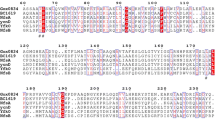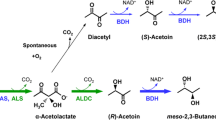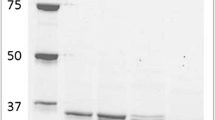Abstract
A gene encoding an NADH-dependent short-chain dehydrogenase/reductase (gox2036) from Gluconobacter oxydans 621H was cloned and heterogeneously expressed in Escherichia coli. The protein (Gox2036) was purified to homogeneity and biochemically characterized. Gox2036 was a homotetramer with a subunit size of approximately 28 kDa. Gox2036 had a strict requirement for NAD+/NADH as the cofactor. Gox2036 displayed preference for oxidation of secondary alcohols and 2,3-diols as well as for reduction of α-diketones, hydroxy ketones, α-ketoesters, and β-ketoesters. However, Gox2036 was poorly active on 1,2-diols and acetoin and showed no activity on primary alcohols, polyols, and aldehydes. The optimum pH values for the oxidation and reduction reactions were 9 and 6, respectively. Gox2036 was highly selective in the reduction of various β-ketones and β-ketoesters. Among the substrates tested, ethyl 4-chloro acetoacetate was reduced to ethyl (R)-4-chloro-3-hydroxybutanoate ester with an excellent conversion yield of 96.9 % and optical purity of >99 % e.e. using an efficient in situ NADH-recycling system involving glucose and a glucose dehydrogenase from Bacillus subtilis (BsGDH).




Similar content being viewed by others
References
Patel, R. N. (2001). Enzymatic synthesis of chiral intermediates for drug development. Advanced Synthesis and Catalysis, 343, 527–546.
Daußmann, T., Rosen, T. C., & Dünkelmann, P. (2006). Oxidoreductases and hydroxynitrilase lyases: complementary enzymatic technologies for chiral alcohols. Engineering in Life Sciences, 6, 125–129.
Kallberg, Y., Oppermann, O., & Persson, B. (2010). Classification of the short-chain dehydrogenase/reductase superfamily using hidden Markov models. FEBS Journal, 277, 2375–2386.
Kavanagh, K. L., Jçrnvall, H., Persson, B., & Oppermann, U. (2008). The SDR superfamily: functional and structural diversity within a family of metabolic and regulatory enzymes. Cellular and Molecular Life Sciences, 65, 3895–3906.
Persson, B., Kallberg, Y., Bray, J. E., Bruford, E., Dellaporta, S. L., Favia, A. D., et al. (2009). The SDR (short-chain dehydrogenase/reductase and related enzymes) nomenclature initiative. Chemico-Biological Interactions, 178, 94–98.
Matsuda, T., Yamanaka, R., & Nakamura, K. (2009). Recent progress in biocatalysis for asymmetric oxidation and reduction. Tetrahedron Asymmetry, 20, 513–557.
Kawano, S., Yano, M., Hasegawa, J., & Yasohara, Y. (2011). Purification and characterization of an NADH-dependent alcohol dehydrogenase from Candida maris for the synthesis of optically active 1-(pyridyl)ethanol derivatives. Bioscience, Biotechnology, and Biochemistry, 75, 1055–1060.
Yamamoto, H., Matsuyama, A., & Kobayashi, Y. (2002). Synthesis of ethyl (R)-4-chloro-3-hydroxybutanoate with recombinant Escherichia coli cells expressing (S)-specific secondary alcohol dehydrogenase. Bioscience, Biotechnology, and Biochemistry, 66(4), 481.
Ye, Q., Ouyang, P., & Ying, H. (2011). A review—biosynthesis of optically pure ethyl (S)-4-chloro-3-hydroxybutanoate ester: recent advances and future perspectives. Applied Microbiology and Biotechnology, 89, 513–522.
Kasai, N., & Sakaguchi, K. (1992). An efficient synthesis of (R)-carnitine. Tetrahedron Letters, 33, 1211–1212.
Teodosiu, D. C., Kirby, D. P. J., Short, A. H., Burden, R. P., Morgan, A. G., & Greenhaff, P. L. (1996). Free and esterified carnitine in continuous ambulatory peritoneal dialysis patients. Kidney International, 49, 158–162.
Wang, G., & Hollingsworth, R. I. (1999). Synthetic routes to l-carnitine and l-gamma-amino-beta-hydroxybutyricacid from (S)-3-hydroxybutyrolactone by functional group priority switching. Tetrahedron Asymmetry, 10, 1895–1901.
Matsuyama, A., Yamamoto, H., & Kobayashi, Y. (2002). Practical application of recombinant whole-cell biocatalysts for the manufacturing of pharmaceutical intermediates such as chiral alcohols. Organic Process Research and Development, 6, 558–561.
Kataoka, M., Rohani, L. P. S., Yamamoto, K., Wada, M., Kawabata, H., Kita, K., et al. (1997). Enzymatic production of ethyl (R)-4-chloro-3-hydroxybutanoate: asymmetric reduction of ethyl 4-chloro-3-oxobutanoate by an Escherichia coli transformant expressing the aldehyde reductase gene from yeast. Applied Microbiology and Biotechnology, 48, 699–703.
Yasohara, Y., Kizaki, N., Hasegawa, J., Wada, M., Kataoka, M., & Shimizu, S. (2000). Molecular cloning and overexpression of the gene encoding an NADPH-dependent carbonyl reductase from Candida magnoliae, involved in stereoselective reduction of ethyl 4-chloro-3-oxobutanoate. Bioscience, Biotechnology, and Biochemistry, 64, 1430–1436.
Yamamoto, H., Mitsuhashi, K., Kimoto, N., Matsuyama, A., Esaki, N., & Kobayashi, Y. (2004). A novel NADH-dependent carbonyl reductase from Kluyveromyces aestuarii and comparison of NADH-regeneration system for the synthesis of ethyl (S)-4-chloro-3-hydroxybutanoate. Bioscience, Biotechnology, and Biochemistry, 68, 638–649.
Kita, K., Kataoka, M., & Shimizu, S. (1999). Diversity of 4-chloroacetoacetate ethyl ester-reducing enzymes in yeasts and their application to chiral alcohol synthesis. Bioscience and Bioengineering, 88, 591–598.
Shimizu, S., Kataoka, M., & Kita, K. (1998). Chiral alcohol synthesis with yeast carbonyl reductases. Journal of Molecular Catalysis B, 5, 321–325.
Xie, Y., Xu, J. H., & Xu, Y. (2010). Isolation of a Bacillus strain producing ketone reductase with high substrate tolerance. Bioresource Technology, 101, 1054–1059.
Ni, Y., Li, C. X., Wang, L. J., Zhang, J., & Xu, J. H. (2011). Highly stereoselective reduction of prochiral ketones by a bacterial reductase coupled with cofactor regeneration. Organic and Biomolecular Chemistry, 9, 5463–5468.
Prust, C., Hoffmeister, M., Liesegang, H., Wiezer, A., Fricke, W. F., & Ehrenreih, A. (2005). Complete genome sequence of the acetic bacterium Gluconobacter oxydans. Nature Biotechnology, 23, 195–200.
Schweiger, P., & Deppenmeier, U. (2010). Analysis of aldehyde reductase from Gluconobacter oxydans 621H. Applied Microbiology and Biotechnology, 85, 1025–1031.
Cao, H., Ye, Q., Zang, G., Yan, M., Wang, Y., Zhang, Y., et al. (2011). Purification and characterization of a novel NADH-dependent carbonyl reductase from Pichia stipitis involved in biosynthesis of optically pure ethyl (S)-4-chloro-3-hydroxybutanoate. Bioresource Technology, 102, 1733–1739.
Otagiri, M., Ui, S., Takusagawa, Y., Ohtsuki, T., Kurisu, G., & Kusunoki, M. (2010). Structural basis for chiral substrate recognition by two 2,3-butanediol dehydrogenases. FEBS Letters, 584, 219–223.
Hosaka, T., Ui, S., Ohtsuki, T., Mimura, A., Ohkuma, M., & Kudo, T. (2001). Characterization of the NADH-linked acetylacetoin reductase/2,3-butanediol dehydrogenase gene from Bacillus cereus YUF-4. Journal of Bioscience and Bioengineering, 91, 539–544.
Prelog, V. (1964). Specification of the stereospecificity of some oxido-reductases by diamond lattice sections. Pure and Applied Chemistry, 9, 119–130.
Bisogno, F. R., Martínez, A. R., Rodríguez, C., Lavandera, I., Gonzalo, G., Pazmiño, D. E. T., et al. (2010). Oxidoreductases working together: concurrent obtaining of valuable derivatives by employing the PIKAT method. ChemCatChem, 2, 946–949.
Ankati, H., Zhu, D., Yang, Y., Biehl, E. R., & Hua, L. (2009). Asymmetric synthesis of both antipodes of β-hydroxy nitriles and β-hydroxy carboxylic acids via enzymatic reduction or sequential reduction/hydrolysis. Journal of Organic Chemistry, 74, 1658–1662.
Nie, Y., Xiao, R., Xu, Y., & Montelione, G. T. (2011). Novel anti-Prelog stereospecific carbonyl reductases from Candida parapsilosis for asymmetric reduction of prochiral ketones. Organic and Biomolecular Chemistry, 9, 4070–4078.
Kataota, M., Sakai, H., Morikawa, T., Katoh, M., Miyoshi, T., Shimizu, S., et al. (1992). Characterization of aldehyde reductase of Sporobolomyces salmonicolor. Biochimica et Biophysica Acta, 1122, 57–62.
Wada, M., Kawabata, H., Kataoka, M., Yasohara, Y., Noriyuki, K., Hasegawa, J., et al. (1999). Purification and characterization of an aldehyde reductase from Candida magnoliae. Journal of Molecular Catalysis B Enzymatic, 6, 280–285.
Jing, K., Xu, Z., Liu, Y., Jiang, X., Peng, L., & Cen, P. (2005). Efficient production of recombinant aldehyde reductase and its application for asymmetric reduction of ethyl 4-chloro-3-oxobutanoate to ethyl (R)-4-chloro-3-hydroxybutanoate. Preparative Biochemistry and Biotechnology, 35, 203–215.
Acknowledgments
This work was financially supported by the National Key Basic Research. Development Program of China (“973” Program, No. 2012CB721003), the Natural Science Foundation of China (No. 21002029/B020706 and 21276084/B060804) and National Major Science and Technology Projects of China (No. 2012ZX09304009).
Author information
Authors and Affiliations
Corresponding authors
Electronic supplementary material
Below is the link to the electronic supplementary material.
Rights and permissions
About this article
Cite this article
Liu, X., Chen, R., Yang, Z. et al. Characterization of a Putative Stereoselective Oxidoreductase from Gluconobacter oxydans and Its Application in Producing Ethyl (R)-4-Chloro-3-Hydroxybutanoate Ester. Mol Biotechnol 56, 285–295 (2014). https://doi.org/10.1007/s12033-013-9707-z
Published:
Issue Date:
DOI: https://doi.org/10.1007/s12033-013-9707-z




